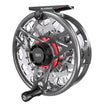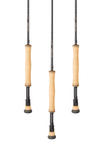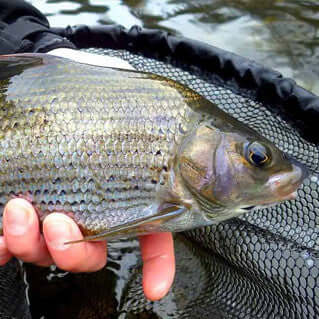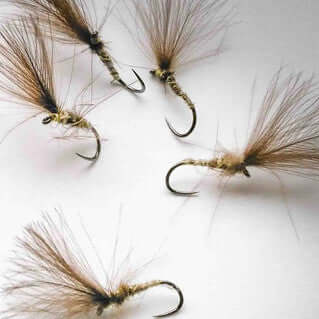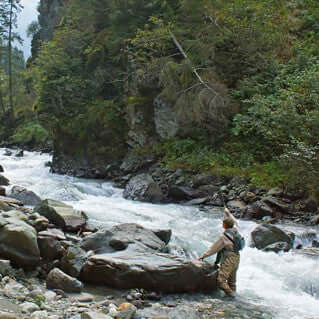Midge, Chironomids, small-teeny-little-things, whatever we call them, trout and grayling only know them as 'reliable food'. They abound trout streams (usually) everywhere in the UK, and are frequently found in substantial volumes. Where you will find trout and/or grayling, chironomids will most definitely be found somewhere (if not everywhere) within the catchment. I'm no entomologist, in fact, far from it. What I do note, however, is the size and shape of the natural residents and, from these notes, I tie my patterns, and this specific pattern does well when fish are feeding on midge and/or small emergers.

Large Grayling
The Chironomid Emerger
is a pattern I picked up from a good fishing buddy of mine, Geraint Meadows, another passionate Usk angler who has a huge amount of midge experience, and to whom I have a huge amount of respect. Geraint first showed me this pattern something close to a decade ago, a pattern so simple, it just had to be deadly; a fact proven by countless fish to the net. Over the years I added the flash 'trigger' with the intention of emulating emerging wings or that small pocket of oil-like substance which chironomids expel in order to rise through the water column as if holding on to a buoyancy aid (that bit of entomology I do know).
A number of years back, I also added the rib, which is created by spinning the tying thread to create a tight rope, before winding up the hook-shank away from the butt-end of the pattern. Do the fish care about the rib? I highly doubt it, but I'm just as passionate about fly tying as I am about fishing, so it's always enjoyable to play with such things. Four simple ingredients. That's it. To be honest, you could probably remove the flash and still do well. So, three ingredients. This isn't a searching pattern, nor is it intended for fast or broken waters. This pattern works well on slower, smoother glides, where 'sippy' trout or grayling have to be targeted from a distance and with longer leaders. This is a challenge I love. The Usk, for example, is the perfect scenario. Clouds of midge can quite often be seen swirling above the surface, and watching these small invertebrates hatch is something of a spectacle.

Brown trout love 'em
Trout will happily gorge on them...
and when you've thrown nearly every fly in your fly box over a sipping trout, I've found it to be this pattern which usually has the best result. At a distance though, the pattern can be a little tough to see, but this can be easily remedied by tying 2-3' of tippet off the hook-shank of a larger, more visible fly and then adding this pattern to said tippet, exactly the same way in which we would fish the Duo/'Klink & Dink'/Dry-Dropper…something micro fly anglers (those opting to fish sub-size #20 patterns) have been doing for years in order to aid visibility (more on this in a future blog article). Longer leaders starting at 12' tapered 5X tippet (circa 5lb), with an additional 3-4' tippet of 6X is my go-to leader setup.
I spent quite a number of seasons obsessing over small micros, and I have something of a love/hate relationship with tippets of 7X and thinner. As fly fishing is, and always will be, a game of balance, finer diameters will aid in better presentation (as well as enabling you to more easily thread the flies), but will increase the risk of tippet breakages for obvious reasons. As such, rods with a through-action, or those with a softer tip section are essential, as that all important softer tip will cushion and help better protect these fragile tippets. So much so in fact, you will be surprised at the size of fish you can land on light tippet; forget using your fast-action/'tippy' rods. Please remember though, and this is the most important part, balancing tippet diameter with potential fish size can be a tricky one. If in doubt, or if that sippy rise on the far bank 'could' be a larger fish, I'll opt to fish a thicker diameter.

Emerger pattern
Tippet strength
I try to put fish safety before the potential of spooking a fish due to thicker tippet. Trout welfare must always come first; playing around with 9X tippet when you know the fish you're targeting could be a 3-pounder simply isn't, generally speaking, responsible angling. Back tracking a little, and I've only pictured the warmer summer months. Colder winter months will also, should temperatures allow, give these small invertebrates the chance to hatch, and I've often used this pattern to target grayling when snow is on the ground during the short twenty-or-so-minute windows in December to January. Again, these need to be targeted. I've fished small (proper small) flies for the last decade in earnest, and I just love tying and fishing them.
Go slow, watch the water for longer periods; wade and cast gently. Midge fishing can be a hugely rewarding way of targeting fish, and a great tool in every angler's bag of tricks. Midge Rule.

Tying Ingredients
- Hook: Partridge of Redditch Grub Straight Eye (K4AY-SE), size #18-#20
- Thread: Semperfli Spyder Thread, black
- Body: Above thread, un-spun so as to be flat
- Rib: Above thread, spun tight into a rope
- Wing/Flash: Micro Flash
- Wing: 3x CDC Plumes, natural
- Thorax: Pine Squirrel or natural Hare's Ear, sparsely dubbed via split-thread, and picked-out ever so.






